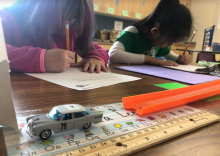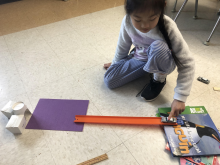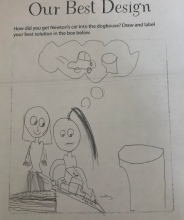Can a collection of matchbox cars and a few hundred dollars really have an impact on STEM education? It did for nearly 350 kindergarten students on the Central Oregon Coast.
The Oregon Coast STEM Hub (OCSH) received a “No Limits” mini-grant from the National Girls Collaborative Project. The grant was written with the goal of creating more opportunities for local students to engage in STEM activities, especially our girls and students of diverse backgrounds. We recognize that not all students have equitable access to STEM experiences that many people think of as “common” for young people, such as playing with matchbox cars and race tracks. We aim to change that one project at a time.

OCSH serves most of the Oregon coast, but this project focused on students in Lincoln County, a rural school district on the Central Oregon Coast that covers an area as large as the state of Rhode Island. Facing the many challenges common to rural school districts (high poverty, limited funding, teacher turnover), teachers in these schools struggle to find the time and resources to bring science/STEM opportunities into their classrooms. This is especially true for primary grades: their daily schedule is tightly bound by reading, writing, and math requirements; and primary teachers often perceive themselves as less prepared for teaching STEM lessons. With this in mind, OCSH partnered with the Lincoln County School District Teaching and Learning Department to use the “No Limit” mini-grant resources to create force and motion exploration kits that could be shared with every kindergarten teacher throughout the school district.
The kits were designed around a science unit from the Picture Perfect STEM series. This is a resource already available to the kindergarten teachers but which had, for lack of time and materials, not been taught in any of the classrooms. The unit, called “Move It”, incorporates reading, writing, science, and engineering standards to engage students in an investigation of force and motion.

The unit starts with the children’s book Newton and Me. The story is a creative introduction to concepts such as force, gravity, and friction through the eyes of a boy and his pet dog, Newton. Then, using the cars and the materials purchased with the mini-grant, students explore how variables such as track height, floor surface, and object weight change how the car moves. Students then do further reading to deepen their understanding of the science concepts through the text, Move It! Motion, forces, and you. Finally, the cars become reimagined as Newton’s car, and the students are challenged to engineer a way to get Newton’s car to “park” in a paper cup dog house without pushing it forward or knocking it over.

The kits were shared around the district during the month of February. Teachers watched the Ewy Rosqvist video in preparation for teaching the lesson and to understand the goal of expanding all students’ vision of what they are capable of. Teachers were thrilled to have all the lesson materials, including the books and the lesson plans, provided at once, in one place. The mini-grant funded enough kits so that all the teachers at each school could have the materials at the same time for a week. This allowed for collaborative planning, which increased the confidence of teachers so they would feel prepared to teach the lessons. Having the kits for a week at a time allowed for flexibility so teachers could find time over the course of the week to teach the unit. Teachers also appreciated that there were enough cars for every child to have one during the investigations, which increased engagement and participation.
Students loved the activities and were excited and proud to show off their work as they explored. The activities challenged them to share, problem solve, and listen to each other’s ideas. They were also challenged to adjust their thinking about what is a “right” answer or a “good” solution. Through creativity and persistence, all the students were able to find their own, unique solution for getting Newton’s car into the dog house. That’s the beauty of STEM, and engineering in particular: there is rarely only one way to solve a problem, and every solution teaches us something new.
Thanks to the “No Limits” mini-grant, teachers in the Lincoln County School district were able to provide an engaging experience to ALL their kindergarten students that just might inspire a new generation of STEM learners in years to come.
Kara Allan
Kara Allan is the Central Coast Coordinator for the Oregon Coast STEM Hub and the Community Curriculum Resource Liaison for the Lincoln County School District.
The Oregon Coast STEM Hub engages learners with Science, Technology, Engineering, and Mathematics (STEM) and Career Technical Education (CTE) by leveraging local and regional resources and collaborating with diverse partners.